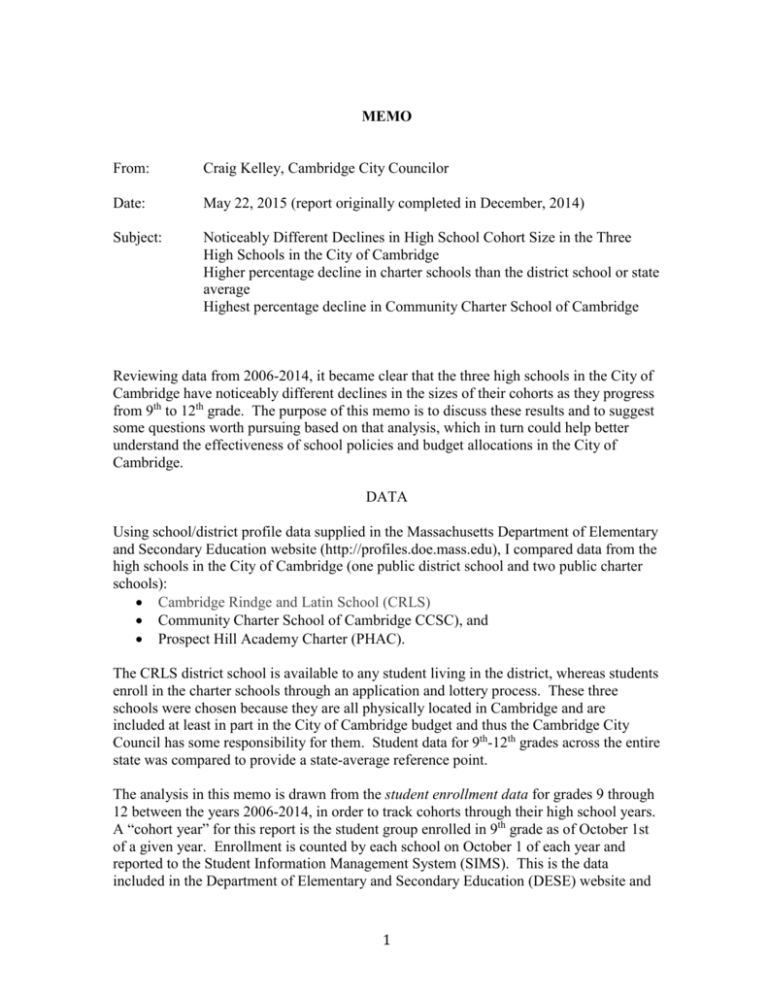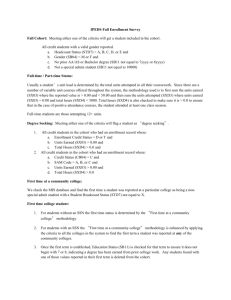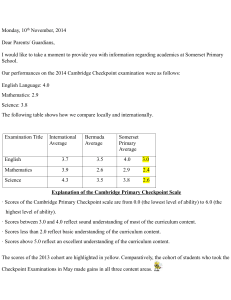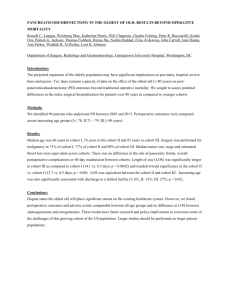Councillor-Kelleys-review-of-Cambridge-High-School
advertisement

MEMO From: Craig Kelley, Cambridge City Councilor Date: May 22, 2015 (report originally completed in December, 2014) Subject: Noticeably Different Declines in High School Cohort Size in the Three High Schools in the City of Cambridge Higher percentage decline in charter schools than the district school or state average Highest percentage decline in Community Charter School of Cambridge Reviewing data from 2006-2014, it became clear that the three high schools in the City of Cambridge have noticeably different declines in the sizes of their cohorts as they progress from 9th to 12th grade. The purpose of this memo is to discuss these results and to suggest some questions worth pursuing based on that analysis, which in turn could help better understand the effectiveness of school policies and budget allocations in the City of Cambridge. DATA Using school/district profile data supplied in the Massachusetts Department of Elementary and Secondary Education website (http://profiles.doe.mass.edu), I compared data from the high schools in the City of Cambridge (one public district school and two public charter schools): Cambridge Rindge and Latin School (CRLS) Community Charter School of Cambridge CCSC), and Prospect Hill Academy Charter (PHAC). The CRLS district school is available to any student living in the district, whereas students enroll in the charter schools through an application and lottery process. These three schools were chosen because they are all physically located in Cambridge and are included at least in part in the City of Cambridge budget and thus the Cambridge City Council has some responsibility for them. Student data for 9th-12th grades across the entire state was compared to provide a state-average reference point. The analysis in this memo is drawn from the student enrollment data for grades 9 through 12 between the years 2006-2014, in order to track cohorts through their high school years. A “cohort year” for this report is the student group enrolled in 9th grade as of October 1st of a given year. Enrollment is counted by each school on October 1 of each year and reported to the Student Information Management System (SIMS). This is the data included in the Department of Elementary and Secondary Education (DESE) website and 1 is the data used in the analysis below. Please see Appendix for direct links to the DESE student enrollment data. FINDINGS Based on my analysis using the DESE website data, there was a noticeable decline in cohort size for all four high school groups (the three Cambridge high schools and the state average) for the cohorts beginning in 2006 through 2011 (six cohorts), tracking each cohort for four years from 9th through 12th grade. Cohort size in the Cambridge Rindge and Latin School (CRLS) declined only 10% overall, which is less than the state average decline of 15% in cohort size. Cohort size in both charter schools declined noticeably more than both the district school (CRLS) and the state average, with Prospect Hill Academy Charter (PHAC) cohort size declining by 22% overall, and Community Charter School of Cambridge (CCSC) declining by 59% overall. In general, through the four years that a high school cohort progressed through grades 912, the cohort size shrunk each year in all four school data sets. The exceptions were: In the Cambridge Rindge and Latin School cohorts that began in 2008, 2009, 2010 and 2011 (the most recent four of the six cohort years), a slight increase in cohort size ranging between 1-5% was reported for 11th grade, but size declined again in 12th grade; and The Prospect Hill Academy Charter cohorts that began in 2006 and 2009 (two of the six cohorts), had a 6% cohort size increase reported for 10th grade, but size declined again in each of the following years. Massachusetts Average School Enrollment 2006-2011 90000 80000 70000 60000 Number of 50000 students 40000 9th Grade 10th Grade 30000 11th Grade 20000 12th Grade 10000 0 2006 cohort 2007 cohort 2008 cohort 2009 cohort 2010 cohort 2011 cohort Year Group of Cohort, starting in 9th Grade 2 Cambridge Rindge and Latin School Enrollment 2006-2011 500 450 400 350 300 Number of 250 Students 200 9th Grade 10th Grade 11th Grade 150 12th Grade 100 50 0 2006 cohort 2007 2008 2009 2010 cohort cohort cohort cohort Year Group of Cohort, starting in 9th Grade 2011 cohort Community Charter School of Cambridge Enrollment 2006-2011 90 80 70 60 Number of 50 students 40 9th Grade 10th Grade 30 11th Grade 20 12th Grade 10 0 2006 cohort 2007 cohort 2008 cohort 2009 cohort 2010 cohort Year group of Cohort, starting in 9th Grade 3 2011 cohort Prospect Hill Academy Charter School Enrollment 2006-2011 100 90 80 70 60 Number of 50 students 40 30 20 10 0 9th Grace 10th Grade 11th Grade 12th Grade 2006 cohort 2007 cohort 2008 cohort 2009 cohort 2010 cohort 2011 cohort Year group of Cohort, starting in 9th Grade Based on the data studied, the only conclusions that can be drawn are statements confined to the enrollment numbers based on enrollment data provided on the Massachusetts Department of Elementary and Secondary Education website. The difference between the percentages of decline in the cohort sizes across the three Cambridge high schools does raise interesting questions. More information is needed, though, to assess whether there are policy implications. Collaborative conversations are needed with each school to determine what light they can shed on these questions. In addition, conversations are needed with the data administrator for the MA DESE to help clarify apparent discrepancies in the data and identify possible causes and solutions. QUESTIONS FOR CONSIDERATION Why is there a greater decline over four years in the size of the charter school cohorts than in the district school cohort? Are there fewer new students entering the higher grades in charter schools because the charter schools do not actively recruit upperclassmen, charter schools do not accept new students after a certain grade or the attraction of scholarship, larger sports teams or larger arts programs of CRLS makes charter schools less attractive to some students? Are a greater percentage of charter school students subject to housing moves out of the relevant school’s district? 4 Could larger charter school cohort shrinkage be due to higher 9th grade repetition rates leading to an artificially large 9th grade cohort? It is possible that CCSC and PHAC both have higher 9th grade repetition rates than CRLS or the state. Initial data review of 8th grade enrollments versus 12th grade enrollments indicated that this factor may somewhat, but not completely, account for the cohort shrinkage differences. Without more data on individual student’s repetition rates it is impossible to determine how many, if any, of a 9th grade cohort are students repeating the grade. Also, since CRLS does not have an 8th grade and draws students from parochial and private schools as well as from the district’s various 8th grades, the complexity of this question increases. Is the difference in suspensions and overall school discipline playing a role in the greater charter school cohort decline? While the data is incomplete and limited to one year, it appears that CCSC's disciplinary rate is over 25%, well above the three other districts reviewed here. CCSC's in- and out-of -school suspension rates, by percentage, are also dramatically higher than the other three districts. SY 2012-2013 Disciplinary Information (http://profiles.doe.mass.edu/) Student Group All PHAC Students All CCSC Students All CRLS Students All State Students % % Out-of% Removed Students % In-School Students School Permanent to Disciplined Suspension Suspension Expulsion Alternate Setting 0 1,165 80 2 5.7 0 388 99 15.2 18.6 0.5 0 1,764 123 3.6 4.3 0 0 979,613 54,453 2.2 4.3 0 0 * Does a higher percentage of in-school suspensions at the charter schools make parents feel the school is not a good fit for their child and they take them out of charter schools and possibly move them to the public school? Does a higher percentage of out-of-school suspensions make it impossible for parents to keep their children in the charter schools because parents are not able to miss work to stay home with their children? Since suspensions might affect scholarship eligibility and college applications, do parents remove students from charter schools in order to maintain a chance at scholarships and college admission? Although suspensions are reported in the MA DESE data, they are not reported by grade so I cannot directly compare suspensions on a grade-by-grade basis. 5 Additionally, DESE only provides disciplinary information for one school year total, so the dataset is not very robust. Does the greater decline in cohort size at charter schools change the make-up of charter vs public school populations? While this report did not closely analyze the selected population reports for the relevant districts, broadly speaking it appears that both CCSC and PHAC serve a higher percentage of “high needs” students than CRLS or the state average. However, because “high needs,” especially “students with disabilities,” is not broken down into meaningful subsets it is not very useful as a comparison between student populations. For example, a student with dyslexia and requiring a minor accommodation would be counted as a student with a disability as much as a student with severe autism even though they are likely to have very different impacts on a school’s learning environment and test scores. Both charter schools have a consistently higher percentage of low-income students than CRLS, though it is not clear that information is very useful as the requirement to submit forms to prove eligibility may corrupt the data from an analytical perspective. To be more useful in helping determine a schools demographics, data should stratify special needs students into subcategories. Currently, the “Special Education” categories listed under “Student” are very general and defined as: o Students who have an Individualized Education Program (IEP), and o “High Needs” students who are, “designated as either low-income, or ELL, or former ELL, or a student with disabilities.” In addition, categories need to be consistently defined. For instance, students with Individualized Education Programs (IEP) are defined as “Special Education” under the “Students” tab, while they seem to be classified as “Students with Disabilities” under the “Accountability and Report Card” tab. In what ways might the difference in decline in cohort size affect achievement ratings? Do students who leave the charter schools represent a particular demographic of the student body that requires more services? When these students leave the charter school, does that change the learning environment in both the charter school and the receiving district school? Are the charter schools able to give their students a particularly high per capita delivery of services in upper grades because their numbers have shrunk so much, while CRLS’s relatively stable population does not allow that option? Does the “opt in” process for charter schools by design create a more motivated student population and a more involved parent body, which is then amplified as the class gets smaller and possibly more selective each year? If Charter Schools are, in fact, losing students who are more difficult to teach, there may be two direct effects: o Charter scores rise; and 6 o The money that otherwise might have been spent on increased services like one-on-one classroom aids or outplacement services is available to spend on other items that benefit all the students. The first point would require a specific review of individual student test score data which I did not have available. The second point would require a more detailed analysis of the relevant school budgets to see how funding streams are impacted. Are similar differences of cohort size shrinkage seen in comparisons between other public and charter schools? Analysis of MA DESE website enrollment data from more areas in Massachusetts could provide MA-specific information. For instance, analyze data to compare the decline in cohort size of Boston charter and public high schools. Where do the students go when they leave a school? Currently I do not know if students who leave CRLS, CCSC or PHA go to private school, move out of district, go to a different charter or public school within the district, drop out, or other. The small school districts in Massachusetts, like Cambridge, make it easy to move out of a district and to lose track of individual students. The data would be more helpful if it clearly followed the individual students and reported where they went and if they eventually graduated from high school. What accounts for the reduction in high school enrollment levels in cohorts on average in Massachusetts and Cambridge schools, even though MA population numbers are going up? Are high school students going to private schools (for which data is not reported to the state), or out of state? Or are there fewer high school aged students in the population? How can Cambridge charter schools claim graduation rates of near 100% when their cohort sizes have declined on average by 22% at Prospect Hill Academy Charter and by 59% at Community Charter School of Cambridge for 4-year cohorts? Are the students counted for cohort size different from the students counted for graduation? If so, how? As I understand it, the cohort graduation rate is calculated by dividing the number of students who graduate within four or five years by the total number in the cohort, being the total cohort [# of 1st time entering 9th graders 4 years earlier] - transfers out + transfers in. So it seems that the differences maybe in the transfers out. A big percentage of students in CCSC are most probably transferring out and the underlying question is “why?” 7 Can the available school data be improved? Open data can be a tremendous resource if it is reported in a way that is accessible to the public, and also uses consistent categories and metrics that make it easy to compare apples to apples. The MA DESE provides a great deal of information, although the categories and definitions are not always the same across data sources and it can be tremendously confusing for people like me who lack expertise in reviewing that data. Most of the data seems to be from the Student Information Management System (SIMS), although a variety of other sources are also used, which may explain the differences. To improve the usefulness of the data, the categories and definitions need to be uniform across platforms. Information needs to be more comparable by providing data sets in comparable values. For instance, graduation rates are in percentages and enrollment rates are in absolute numbers and it is not clear if the populations are the same, making it impossible to draw accurate conclusions. Student groups are not consistently defined or represented. For instance, students with Individualized Education Programs (IEP) are defined as “Special Education” under the “Students” tab, while they are classified as “Students with Disabilities” under the “Accountability and Report Card” tab. CONCLUSION The sizeable differences in the declines in cohort sizes among the high schools located in the City of Cambridge raise important questions. That CCSE can lose almost 60% of its 9th graders by the time the cohort is in 12th grade is immensely troubling and requires specific attention to clarify, but there should be concern about declines in all the districts’ cohorts. It would be beneficial to gather more information through collaborative conversations with administrators at the three schools, and with the data administrator for the MA DOESE to help answer questions. APPENDIX STUDENT ENROLLMENT DATA LINKS Please note that these link to the 2014 year. To see other years click on the Year arrow (“2014”) in the upper left. Cambridge Public High School student enrollment data http://profiles.doe.mass.edu/profiles/student.aspx?orgcode=00490000&orgtypecod e=5& Community Charter School of Cambridge student enrollment data http://profiles.doe.mass.edu/profiles/student.aspx?orgcode=04360000&orgtypecod e=5& Prospect Hill Academy Charter student enrollment data http://profiles.doe.mass.edu/profiles/student.aspx?orgcode=04870000&orgtypecod 8 e=5& State of Massachusetts student enrollment data http://profiles.doe.mass.edu/profiles/student.aspx?orgcode=00000000&orgtypecod e=0& DEFINITIONS and sources of data categories in MA DOESE school profiles can be found here -- http://profiles.doe.mass.edu/help/data.aspx?section=students BACKGROUND ON CAMBRIDGE SCHOOLS Cambridge, Massachusetts is home to three high schools. The Cambridge Public School District’s (CPSD) high school is Cambridge Rindge and Latin School (CRLS) and serves any Cambridge residents of high school age. It accepts students from CPSD’s five 8th grades and numerous private or parochial schools that stop at 8th grade. CRLS has roughly 1740 students in grades 9-12 age at its mid-Cambridge campus. (http://profiles.doe.mass.edu/profiles/student.aspx?orgcode=00490000&orgtypecode=5&) The Community Charter School of Cambridge (CCSC) is located in East Cambridge and serves roughly 375 students from grades 7-12. (http://profiles.doe.mass.edu/profiles/student.aspx?orgcode=04360000&orgtypecode=5&) The Prospect Hill Academy (PHA) serves roughly 1150 students from grades K-12 on two campuses with roughly 500 students in grades 7-12 at its central Cambridge campus and the earlier grades being in Somerville. (http://profiles.doe.mass.edu/profiles/student.aspx?orgcode=04870000&orgtypecode=5&) Charter Schools in Massachusetts receive funding from the Districts that send students to those charter schools equal to the average amount the particular district spends per student multiplied by the number of students attending that charter school from the sending District. Thus, Cambridge’s high per student expenditure, well above $20,000, makes it an attractive district from which to pull students. (http://www.cpsd.us/UserFiles/Servers/Server_3042785/File/Migration/FY15_Budget_Ad justments.pdf?rev=0) The City annually spends roughly 11 million dollars per year on charter school payments. (http://www.cambridgema.gov/~/media/Files/budgetdepartment/FinancePDFs/FY15%20S ubmitted%20Budget%20Book.ashx, p. IV-396) The number of students from Cambridge that can attend any particular charter school is limited per each individual charter school’s charter but this study did not ascertain how many Cambridge residents are attending either CCSC or PHA. Charter schools enroll students based on a lottery. Families apply to attend a charter school and, if accepted, the children may go to the relevant charter school. Students who do not get into a Charter school via the lottery, choose not to attend after having been admitted via the lottery or cease to attend a Charter School for some reason are eligible to attend the “District School” of the municipality in which they live. Charter schools have different union, collective bargaining and other rules from District schools. 9 SELECTED SPREADSHEET DATA (Complete excel source files available upon request) 10 11









